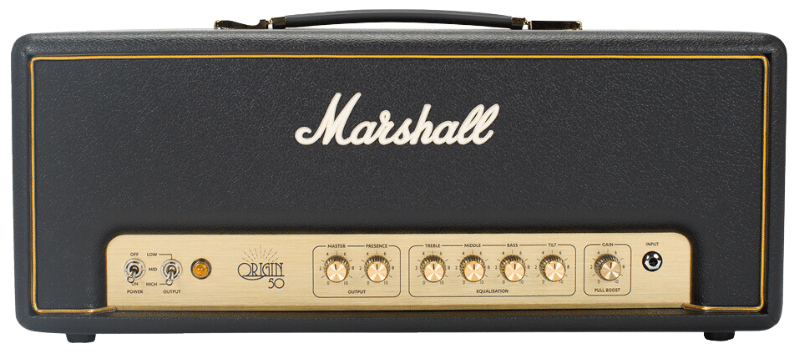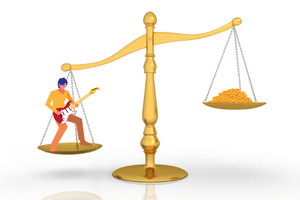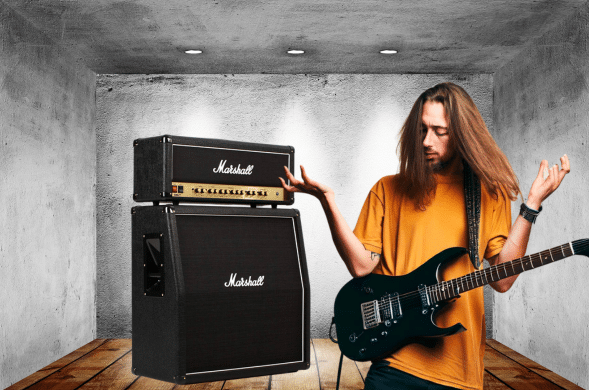So, is 50 Watts enough headroom for a guitar amp? You’ve probably asked yourself this question, especially if you play the electric guitar. Whether you’re looking to perform at a crowded venue or want to make your home studio recordings sound great, having an amp with just the right power output and headroom can make all the difference!
In this article, I’ll reveal everything you must know and debunk the myth that more power with more headroom is always the best way to go.
If you want to skip the preliminary info and go directly to the heart of the question, you can click here. Otherwise, keep reading, and you’ll get there shortly.
Also, you can use the table of contents below to take you to the area that interests you. Click on the little box to open it, and then click on the section of the article you want to read, or you can read from start to finish if you want the full amplification experience!
The Short Answer
The power rating of a guitar amplifier is more about headroom than volume. A 200-Watt amp is only twice as loud as a 20-Watt amp. Guitars with lower headroom distort at lower volumes, while those with higher headroom stay cleaner-sounding at higher volume settings. A 50-watt amp can deliver clean headroom and great distortion at practical volume levels.
Keep On Reading (Below.) To Learn More
Understanding Amp Headroom
First things first. What is amp headroom? In simple terms, headroom is the difference between the cleanest signal your amplifier can produce and the point at which it begins to distort.
In a more technical sense, headroom refers to the difference in decibels (dB) between an amplifier’s nominal operating level (the level at which it is designed to operate for the best performance) and its maximum level before the onset of clipping (distortion caused by exceeding the amplifier’s capabilities).
This is particularly important for certain styles of music that require clean, clear tones, even at high volumes. The more headroom you have, the louder your clean tones can be. If you’re a fan of those crystal-clear, ringing notes, headroom is your best friend. We’re talking about musicians like Country and Jazz players here.
On the other hand, an amp with less headroom will distort at lower volumes, which might be desirable for some styles of music, such as Rock, Blues, and Metal.
The wattage of an amp often gives a rough indication of its headroom. However, many other factors, like the amplifier’s design, the type of tubes (if it’s a tube amp), and even the speaker’s efficiency, can also influence an amplifier’s headroom.
So, let’s get rid of the idea that more headroom is always better and dispel the concept that high-powered amps cannot be designed to have low headroom. These two statements could not be further from the truth!
Why 50 Watts?

So, why are we talking about 50 watts? Well, 50 watts is a common mid-range wattage for guitar amps. It’s become a popular choice for players that need the power to do live gigs but want a versatile amp for lower-volume recording dates.
50 Watt amps are powerful enough to give you a decent amount of volume and clarity, and let you turn the amp up enough to get some natural overdrive without totally blowing the windows out of the house.
Mid-range wattage can be especially important for amps that don’t have a master volume control, which allows the pre-amp section to be dialed up so that the amp section can distort at a lower overall volume.
Non-master volume 100 Watt amps typically had to be ear-splitting loud to get Rock sounds before distortion pedals were available.
Therefore, players who ask me about headroom are usually looking at an amp with a power rating of about 50 Watts RMS. Guitarists that want lower-powered amps, like five to ten watts, are usually less interested in the unit’s headroom since they want to open it up to grab as much natural sustain and distortion as possible.
Do 50 Watts Give You Enough Headroom?
Now, is 50 watts enough headroom for a guitar amp? Here is where we’ll begin to look at what we need to consider to answer this question.
This is where it gets a little tricky because the answer is: it depends. What does it depend on, you ask? It boils down to the sound you are looking for and four essential factors: your guitar, amplifier, venue, and personal preference.
The Guitar You Use
Let’s start with your guitar. Different guitars have different output levels. A guitar with high-output humbucking pickups, for instance, is louder and will require more headroom to keep the sound clear.
So, if your guitar fits this description, a 50-watt amp may not provide you with the clean tone you desire at a high volume level. However, if you want to push your amp to get a naturally overdriven lead sound, this is the way to go!
Your Amplifier
To get a better idea of how amplifier design figures into the big picture, let’s start with a table that compares the pros and cons of guitar amplifiers with more and less headroom.
| Pros & Cons | More Headroom | Less Headroom |
|---|---|---|
| Pros | – Allows for cleaner and louder tones – Offers more control over your tone at higher volumes – More flexibility with a range of effects pedals – Less likely to distort the sound at higher volumes – More suitable for a wider range of music styles due to its versatility – Better suited for high-output pickups, maintaining a clean tone even at high volumes | – Can achieve natural tube overdrive at lower volumes – Great for genres that require a “grittier” or “dirtier” tone – Smaller, lower wattage amps can be more portable – May be more cost-effective, as amps with less headroom often cost less – Can contribute to a unique and distinctive sound, especially for Blues or Rock genres |
| Cons | – May be heavier and more expensive – Might be too loud for small venues or home practice – May not produce natural overdrive as easily – Might require more maintenance, particularly for tube amps with high wattage – Can be overkill for simple practice or small venue performances | – Clean tones can distort at higher volumes – May not be loud enough for larger venues or band practices – Less control over the tone at high volumes – Might not provide the flexibility needed for a wide variety of music styles – May struggle to provide clean output with high-output pickups, particularly at higher volumes |
Remember that while this table offers a generalized comparison, the pros and cons can shift depending on your specific amp, style, and performance needs. The key is to explore various options and find what works best for you!
Headroom Can Vary Among American And British Model Amplifiers
Headroom can indeed vary significantly depending on the brand and model of the guitar amplifier. Factors influencing this include the design of the amp, the tubes used, the wattage, and even the style of music the amp is traditionally used for. It’s crucial to think about the sound you’re trying to achieve and the gear that will best help you realize your tonal requirements.
American amplifiers, such as those by Fender and Mesa Boogie, and British amplifiers, including Marshall and Vox, are known for their distinctive tonal characteristics. These tone differences result from the amplifiers’ design, which can also affect the headroom they offer.
American Amplifiers
For example, consider a classic American amplifier, the Fender Twin Reverb. It’s known for its bright and clear tones with ample headroom, allowing for loud, clean sounds even at high volumes. The Twin Reverb is an 85-watt tube amplifier, which translates into generous headroom. This is why it’s favored by many players who need a clean, crisp sound or play genres like Country, Jazz, and Blues that often require clean, undistorted tones.
On the other hand, look at the Mesa Boogie Mark Series. These are also American amps, but they come with a more complex tonal palette. The Mark V, for instance, is known for its “high-gain” capabilities. This means the amp naturally distorts at lower volumes, thus offering less clean headroom than the Fender Twin Reverb.
British Amplifiers
Now, let’s cross the pond and look at the British amps. A Marshall JCM800, a staple of British amplification, is often used for rock and roll due to its warm, crunchy tone. This amp is known for its overdriven sounds rather than sparkling clean tones. The JCM800’s 100-watt version does provide decent headroom, but the nature of the amp’s tone is such that it is often used for its rich distortion rather than its clean sounds.
Finally, consider the Vox AC30, another quintessentially British amp. Its charm lies in its jangly, chimey tones that begin to break up quite early as you crank the volume. It’s a 30-watt amp, so naturally, it won’t have the same clean headroom as the higher-wattage amps we’ve discussed. The Vox AC30 is loved for this very reason: its ability to provide a warm overdriven sound at lower volumes while still retaining clarity.
Headroom Can Also Vary With Class A & Class AB Amplifiers
Class A and Class AB refer to the amplifier’s output stage configuration, which can significantly impact the amp’s performance and tone.
Class A Amplifiers:
Class A amplifiers are designed to conduct signal over the entire range of the input cycle, meaning they have current running through the output tubes at all times. This continuous current flow makes them less efficient and hotter, but it allows them to deliver a very responsive and smooth tone.
Class A amps typically have less headroom than Class AB amps. Class A amps typically begin to distort quite early as you increase the volume, meaning you get a beautiful natural overdrive but less clean headroom.
Class AB Amplifiers:
Class AB amplifiers, on the other hand, conduct signal for less than the entire input cycle. The output is split between two sets of tubes, with each set handling a part of the signal waveform. This design makes them more efficient and less hot than Class A amps.
As for headroom, Class AB amps typically have more than Class A amps. They can provide a cleaner tone at higher volumes before the signal starts to distort.
Remember:
Whether Class A or Class AB suits you better depends on your playing style and the tone you’re seeking.
If you want an amp that breaks up early for that warm, vintage overdrive, a Class A amp might be your pick. But if you need an amp that stays clean at higher volumes, providing a solid platform for your effects, a Class AB amp could be your ideal companion. As always, listen to your ears and let your personal taste guide your choice!
The Venues You Play
Moving on to your venues. Are you playing at a small club or a large stadium? If you’re in a smaller space, 50 watts will likely be more than enough headroom. But in larger venues or for outdoor performances, you might find that 50 watts don’t quite hit the back row with the same level of clarity. However, you can always mix your amp into the house PA system.
Your Personal Preference
Lastly, let’s talk about personal preference. Every guitarist has their unique style and tone preference. You might prefer an amp with less headroom if you enjoy crunchy, overdriven tones. On the other hand, if you’re a fan of clean tones or play a lot of intricate, melodic lines, a higher headroom might serve you better.
Why Power And Headroom Is A Balancing Act!

Generally speaking, the key here is to find a balance between your needs and the amp’s capabilities. A 50-watt amp offers enough headroom for most mid-sized gigs, band practices, and home recordings. It’s a versatile choice that covers a broad spectrum of sounds, from soft, clean passages to full-on rock anthems.
However, for larger venues, or if you’re using high-output pickups and want clean tones at high volumes, you might need an amp with more than 50 watts. If you’re unsure, it’s always a good idea to try out different amps to find one that suits your personal style and the specific demands of your performance environment.
So, while the “perfect” wattage may not exist, 50 watts provides a happy medium for most guitarists out there. Like everything in the realm of music, it’s all about experimenting and finding what works for you. Don’t be afraid to tweak, tune, and turn up those amps to discover your perfect sound. Remember, the best tone is the one that makes you sound awesome, and love playing your guitar even more!
I’ll get more specific about my particular preferences in the next section.
Why I Prefer The Headroom Of 50-Watt Amps

I have guitar amplifiers of all designs and sizes, but overall, I find that 50-watt amps provide me with the perfect balance between power, headroom, tonal quality, ad playability! Let me explain why.
Here are some of the reasons why I think 50-watt guitar amps strike a perfect balance between lower and higher power output amps, especially when it comes to tone and playability.
Versatility
A 50-watt amp straddles the line between smaller practice amps and larger performance amps, making it a versatile choice for a variety of scenarios. Whether I’m practicing at home, recording in my home studio, or performing in a smaller venue, a 50-watt amp can usually handle it all.
Tone
A guitar amp’s appeal often lies in its tone, and for me, 50-watt amps strike a unique tonal balance.
They can achieve a sweet spot of overdrive tone without becoming too muddy or excessively loud, unlike higher-wattage amps that may stay too clean at lower volumes or lower-wattage amps that might break up too early. A 50-watt amp can deliver clean headroom and great distortion at practical volume levels.
Controlled Overdrive
Expanding on what I wrote above, 50-watt amps can provide an optimal blend of clean and overdriven tones. They start to break up at a point that’s generally well-suited to live playing, allowing me to utilize the amp’s natural overdrive while still maintaining control over my tone.
If I need more overdrive or distortion, I can always kick in a dirt pedal to push me over the top for that more aggressive guitar solo.
Higher wattage amps can be harder to push into their sweet spot without excessive volume, while lower wattage amps may not offer as much clean headroom before distorting.
Dynamic Response
Amps with around 50 watts usually offer me a satisfying dynamic response. They’re able to react well to my touch, providing just the right tonal change as I alter my picking or strumming intensity. This makes them excellent for me because I’m an expressive player who likes to vary my dynamics.
Portability And Size
While not directly related to tone or playability, the size and portability of a 50-watt amp are practical benefits. They are generally more compact and lightweight than higher-wattage amps, making them more manageable for me as a gigging musician. The older I get, the heavier these amps seem to be! Lol
Summing Up My Thought Process
So, 50 watts, like my Marshall 1987X, generally gives me just enough headroom for an all-purpose guitar amp. If I need something a little cleaner sounding, I’ll normally plug into something with a bit more power, like my Fender 85-Watt Twin Reverb.If I’m looking to get more on the naturally dirty side, then I’ll go with something like my Soldano Atomic 16 (Watt) amp. A good pedalboard can give you everything in between.
Don’t Fall Into The “Bigger Is Better” Trap!

When I was in high school back in the 1960s, I thought that the “bigger the better” was always the way to go with guitar amps. To me, nothing beat a wall of Marshall stacks, and I used to dream of covering an entire wall inside my home with them! Lol
However, I’ve come a long way in my thinking over the years! Things like versatility, tonal balance, and controlled overdrive are more important than size and the “cool factor,” although I hate to admit it!
It’s essential to choose an amp based on your particular needs and personal preference and to use your ears to help you find what works best. After all, the best gear is the gear that inspires you to play!
Key Takeaways

Here is a review of the essential points you have learned in this article.
- Headroom is the dB difference between nominal operating level and maximum distortion level.
- It determines the volume an amp can handle without distortion.
- Higher headroom allows cleaner tones at higher volumes; lower headroom distorts earlier.
- Headroom is vital for genres requiring clear tones, especially at high volumes.
- Amp wattage gives a rough idea of headroom, but other factors matter too.
- Design, tubes (in tube amps), and speaker efficiency affect an amp’s headroom.
- Balancing headroom and distortion is a personal preference based on musical style.
- More headroom provides a wider dynamic range for expressive control.
- High headroom amps excel at clean tones; low headroom amps are great for overdrive.
- Understanding an amp’s headroom helps make informed gear choices and tone customization.
Frequently Asked Questions

Here are some of the questions I get asked about 50-Watt guitar amps and headroom.
If your question does not appear here, please put it in the comments, and I will get right back to you with an answer.
What Specific Brands Are Known For Their 50-Watt Amps?
Brands like Marshall, Fender, Mesa Boogie, and Orange have popular 50-watt amp models.
Can A 50-Watt Amp Be Used With Pedals?
Absolutely! 50-watt amps work well with a variety of pedals, allowing you to shape your tone further.
Are There Any Differences In Headroom Between Tube And Solid-State Amps?
Generally, tube amps exhibit more dynamic headroom, while solid-state amps can offer cleaner headroom at higher volumes.
How Does Speaker Efficiency Affect Headroom In A 50-Watt Amp?
More efficient speakers can make a 50-watt amp sound louder and provide a perception of increased headroom.
Is 50 Watts Too Loud For Home Practice?
It can be, but you can control the volume by adjusting the amp settings and using attenuators or volume pedals.
Can A 50-Watt Amp Handle Large Venues?
It depends on the specific circumstances, but for most medium-sized venues, 50 watts is sufficient.
Is 50 Watts Enough For Playing In A Band?
It depends on the band’s volume level and the desired amount of clean headroom. It can work well in many band situations.
Final Thoughts

So, is 50 watts enough headroom for a guitar amp? The answer lies in your hands, or more precisely, in your style, guitar, and venue. In many cases, a 50-watt amp will hit that sweet spot, providing a stellar balance between volume and tone clarity. It’s perfect for the guitarist seeking to light up local gigs, band rehearsals, and home studios with a clear and balanced sound.
However, if you’re playing for a large crowd or need crystal clear notes at high volumes with high-output pickups, you might want to look for an amp with a higher wattage. And, of course, there’s always room for personal preference!
Or, perhaps you love the rough, gritty tone that comes from pushing your amp into natural overdrive, in which case lower headroom might be your jam.
Whatever your needs are, remember that wattage is just one piece of the tonal puzzle. A 200-Watt amp is only twice as loud as a 20-Watt amp. Your choice of guitar, pedals, and even the pick you use can also drastically affect your sound. Feel free to play around, try different combinations, and let your ears be the final judge.
In the end, while 50 watts may not be the ultimate answer for everyone, it is undoubtedly a great starting point for many. It’s a versatile, user-friendly option that can cater to various styles and settings. So plug in, power up, and let your musical journey take you to exciting and electrifying places!

Here’s a video from Wampler that demonstrates the fundamental difference between a 50-Watt and a 100-watt guitar amplifier. Check it out!
What To Read Next ➡ What Size Guitar Amp Do You Need? – Ultimate Guide!
Related Article ➡ Is Your Guitar Amp Gain Too High? – Master Your Tone!
Tell Me What You Think

Please leave a comment below if you enjoyed this article, have any questions about 50-Watt amps or headroom, or want to give your point of view. I will be happy to help you.
- Do you favor low, medium, or high-powered amps? Why?
- How do you use your amp’s headroom?
- What is the best amp you’ve ever had?
- What else is on your mind?



Hi! Just read your article. Wow! You really know your stuff. Very knowledgable and interesting, and you made it fun! Back in my 20’s I used to play a bass in a band. It was so fun, but we all have to grow up. hahaha
My son was also in a band and seemed like he always said he needed a new amp. ; )
Anyways, great article and keep good work!
Hi, Sandi
I’m thrilled that you liked my article!
As far as the bass playing is concerned, it’s never to late to start again. You don’t need to be in a band to have fun with it, just find a way to fit it into you busy schedule. 😎
Rock On! 🤘
Frank 🎸
I want to thank you Frank for writing such an informative article on the topic of guitar amplifier “headroom” and taking the time to explain exactly what that means for a novice such as myself. I am a novice when it comes to all this technical electric guitar equipment and am not a musician of any kind but still find myself often shopping for various musical instruments and components because my musician daughter will occasionally ask me to check into this piece of equipment or that because she is in need of an upgrade.
You explanation of what amplifier “headroom” actually means helped me to make sense of some of the conversations I have had with her about her style of music and the particular components that she could likely benefit from.
Hi, Joseph
Thank You for your comments!
So glad I was able to help!
Let me know if you have any questions regarding amplifier power output and headroom.
Rock On! 🤘
Frank 🎸